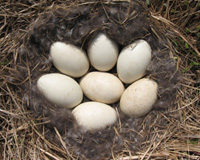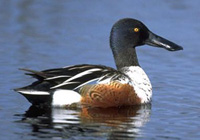|
Cooperative Management
Biologists from state, federal, and provincial wildlife
and land-management agencies, university students and faculty, and others
develop management plans for the cooperative management of migratory bird
populations in the Pacific Flyway. Biologists from the Central Flyway, Canada,
Mexico, and Russia contribute to these plans.
Management Plans Available
The Pacific Flyway Council has prepared more than 28
management plans to date. The Pacific Flyway Representative
of the U.S. Fish and Wildlife Service in Portland, Oregon has
 copies of all management plans.
You may request a copy of a plan by contacting the
Service representative. Management plans
are available electronically in PDF format and may be obtained by clicking
on the plan listed in the sidebar.
copies of all management plans.
You may request a copy of a plan by contacting the
Service representative. Management plans
are available electronically in PDF format and may be obtained by clicking
on the plan listed in the sidebar.
What Is a Management Plan?
Flyway management plans are products of the Council,
developed and adopted to help state and federal agencies cooperatively manage
migratory birds under common goals. Management strategies are recommendations
and do not commit agencies to specific actions or schedules. Fiscal,
legislative, and priority constraints influence the level and timing of
management activities.
Management plans serve multiple purposes:

- Identify common goals.
- Establish priority of management actions and responsibility for
them.
- Foster collaborative efforts across geo-political boundaries.
- Coordinate collection and analysis of biological data.
- Emphasize research needed to improve conservation and management.
Management plans typically focus on populations, which are the primary unit
of management, but may be specific to a species or subspecies. Management of
some migratory birds requires coordinated action by more than one flyway
(e.g., Rocky Mountain Population of Greater Sandhill Cranes, Four Corners
Population of Band-tailed Pigeons, peregrine falcon take allocation).
Development Process
Subcommittees of the Study Committee and Nongame
Migratory Bird Technical Committee develop and update management plans. Once
a subcommittee has developed an acceptable draft plan or plan revision, the
Study Committee or Nongame Migratory Bird Technical Committee reviews it.
After necessary revisions and editing, that committee adopts a formal
recommendation approving the plan and forwards it to the Council for review.
The Study Committee and Nongame Migratory Bird Technical Committee usually
works on management plans during the winter (December or January) meeting,
and sends them to the Council for review during the spring (March) meeting.
The Council usually votes on plans at the following summer (August or
September) meeting.
The Council adopts management plans, making them formal documents.
Multi-flyway plans require concerted
 and concurrent review and approval.
and concurrent review and approval.
In the Pacific Flyway, management plans generally have a 5-year planning
horizon with revisions as necessary to provide current guidance.
Photo credit: waterfowl nest, T. Sanders; white-winged dove, G. Andrejko;
northern shoveler, photographer unknown.
|



